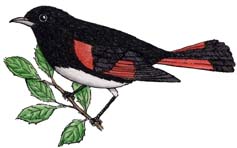

They are found in southern Alaska across Canada to Newfoundland and south throughout the eastern part of the U.S. They winter in the southern part of their range through the Midwestern U.S.
They are located in deciduous forests and thickets.
They are black with patches of sandy, orange on their wings and tail.
Females are brown with yellow patches.
They eat insects that they catch right out of the air.
Females build an open cupped nest of grass and bark on a tree branch near the trunk of the tree. They sometimes use the old nest that another bird had left. The female lays 4 eggs that she warms (incubates) for 2 weeks.
Kingdom: Animalia
Phylum: Chordata
Subphylum: Vertebrata
Class: Aves
Order: Passeriformes
Family: Parulidae
Genus: Setophaga
Species: S. ruticilla
When you research information you must cite the reference. Citing for websites is different from citing from books, magazines and periodicals. The style of citing shown here is from the MLA Style Citations (Modern Language Association).
When citing a WEBSITE the general format is as follows.
Author Last Name, First Name(s). "Title: Subtitle of Part of Web Page, if appropriate." Title: Subtitle: Section of Page if appropriate. Sponsoring/Publishing Agency, If Given. Additional significant descriptive information. Date of Electronic Publication or other Date, such as Last Updated. Day Month Year of access < URL >.
Amsel, Sheri. "Redstart (American)" Exploring Nature Educational Resource ©2005-2024. December 14, 2024
< http://exploringnature.org/db/view/135 >

